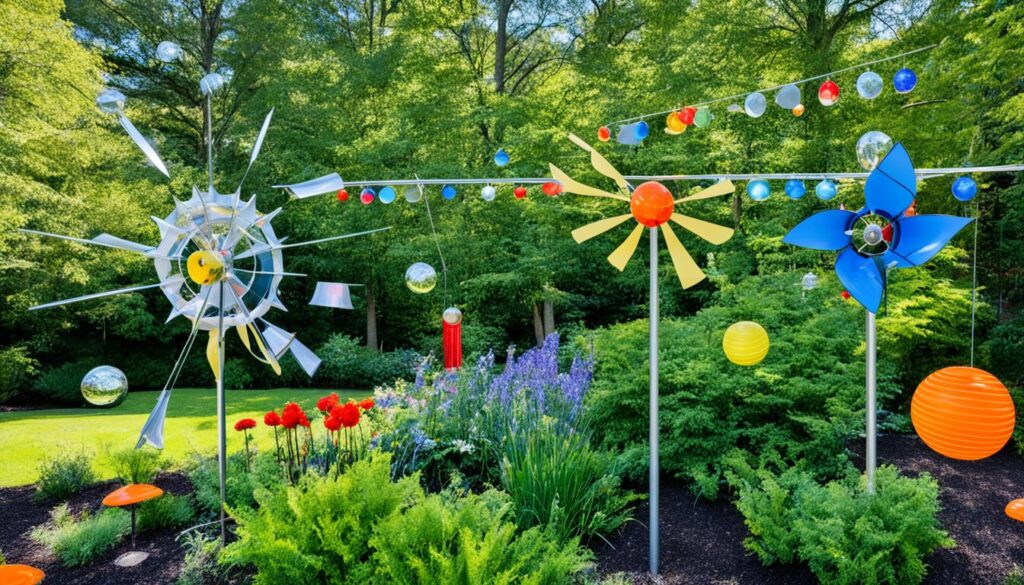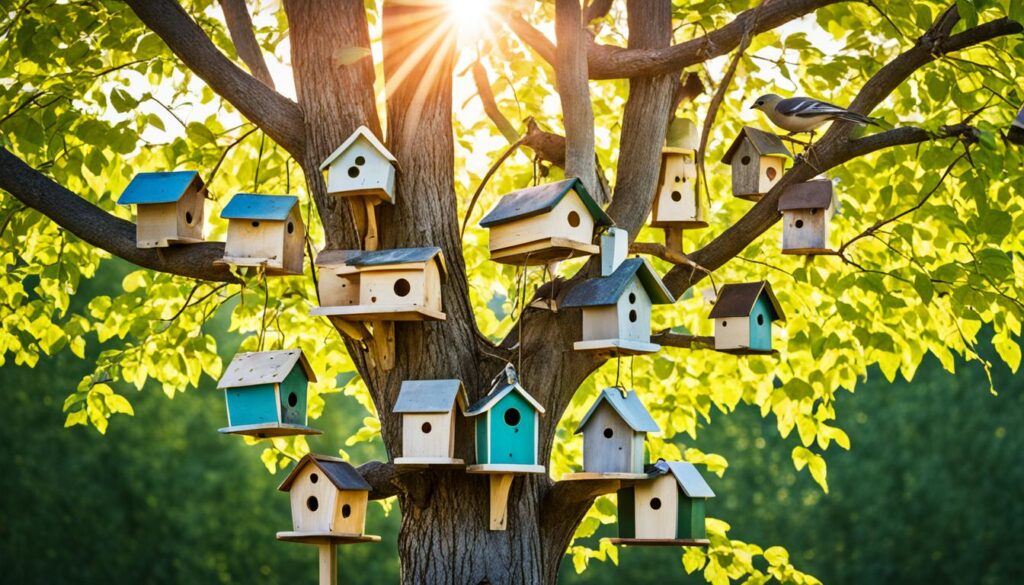Imagine being woken up very early by loud bird calls. This happens to lots of people in the U.S. About 1 in 10 say they deal with noisy birds every day.
From the early songs of Northern Mockingbirds to the constant chirping of House Sparrows, finding peace at home is tough. But, there are ways to make your yard quieter, without hurting the birds.
Key Takeaways
- Understand the natural behaviors that drive birds to chirp, such as establishing territory and attracting mates.
- Utilize physical barriers like closed windows and curtains to block exterior bird noise.
- Strategically place bird feeders to lure feathered friends away from high-traffic areas.
- Leverage soothing sounds like wind chimes and white noise machines to mask unwanted bird calls.
- Collaborate with neighbors to address shared concerns about disruptive bird activity in the area.
Understanding Bird Behavior: Why Birds Chirp at Dawn
The early morning is filled with the sweet sounds of birds singing just before the sun comes up. This time, called the dawn chorus, is when many birds, like the Northern Mockingbird, sing loudly and a lot. They do this to mark their area and attract a mate.
Birds Sing to Establish Territory and Attract Mates
Males sing mostly in the pre-dawn hours to guard their space or find a partner. The cool and calm mornings let their songs carry far. This way, they let other birds know where their area is and show they are the boss.
Some studies have found that a few sparrow types sing as well at noon as they do at dawn. But, the early hours are quieter and their songs are clearer. This makes it easier for them to communicate their messages to others.
The Culprit: Northern Mockingbirds and Their Nighttime Singing
Unlike most birds, the Northern Mockingbird may sing at night too. They are great mimics, copying various sounds. But, their night singing can keep people awake, especially if they live nearby.
Figuring out why these birds sing at night is key to dealing with the noise. Knowing it’s about marking territory and finding a mate can help find peaceful ways to live with them.
“The ability to sing loudly and clearly in the early morning, without the advantage of warming up or a hearty breakfast, signifies a strong mate and a formidable defender of territory in the bird world.”
Blocking Exterior Noise: The Power of Closed Windows and Curtains
Want to stop bird noises from disturbing you? Simply close your windows and draw the curtains. This easy step can reduce the loudness of bird sounds you hear indoors.
Your windows let a lot of outside noise in, especially bird calls. They’re the easiest place for sound to get through. By keeping your windows shut tight, you keep a lot of that noise out.
Add thick, sound-absorbing curtains to your windows for better results. Acoustic curtains are made to stop sound from coming in. They’re not too expensive, priced at just $20 to $60 per panel.
Make sure your windows and curtains fit well together. Small openings can let noise through. Use special caulk or seals to close any gaps and add even more noise protection.
Curtains and closed windows are just the start. You can also get stronger, layered windows. And consider sound-absorbing insulation and window additions for more noise reduction.
| Soundproofing Solution | Cost Range | Noise Reduction Potential |
|---|---|---|
| Window Inserts | $300 – $800 per insert | Soundproof windows typically measure between 48 and 54 on the STC scale for noise reduction. |
| Replacing Single-Pane Windows with Double-Pane | $350 – $900 per window | Single-pane windows have an STC of between 26 and 28, while double-pane windows typically have an STC ranging from 26 to 35. |
| Acoustic Caulk | $10 – $20 | Sealing window gaps with acoustic caulk can significantly reduce the amount of noise entering the home. |
| Sound-Reducing Curtains | $20 – $60 per panel | Specialized soundproofing curtains can absorb and reflect sound, providing an additional layer of noise reduction. |
Using closed windows and curtains works. It helps block outdoor noise like bird sounds. That way, you can enjoy a quieter, more serene home.

Relocating Bird Feeders: Luring Feathered Friends Away
Tired of loud birds near your home? One trick is moving your bird feeders. By getting birds to feed elsewhere, you can have peace at home. You’ll still see and hear the wildlife from a nice, quiet distance.
Strategically Placing Bird Feeders for a Quieter Environment
To move feeders right, you need to know what birds like. Experts say put them 30 feet from your house in dense areas. This way, they migrate to a peaceful spot to sing and eat.
When choosing a new spot, look for these things:
- Places with lots of plants where birds can hide and live
- An area where you can see the birds from far without hearing them too much
- Put the feeders right to keep birds from areas you use a lot
| Feeder Type | Recommended Placement | Targeted Bird Species |
|---|---|---|
| Tube Feeders | In the middle of a tree canopy or near dense shrubs | Finches, chickadees, titmice |
| Platform Feeders | On a pole or tree stump in an open area | Sparrows, jays, mourning doves |
| Suet Feeders | Attached to tree trunks or under eaves | Woodpeckers, nuthatches, brown creepers |
Smartly moving feeders creates a quiet spot at home. It keeps birds off loud places. You’ll enjoy peaceful birdwatching as a result.
Window Decals: A Reflective Deterrent for Nearby Birds
Are birds keeping you up at night or making your days hard? Window decals might be the answer. They reflect light and make birds think there are obstacles, stopping them from coming close and lowering the noise they make.
Birds don’t like the look of window decals. They see the shiny surfaces and think they’re real barriers. This works well against birds like Northern Mockingbirds that sing all night long.
To use window decals best, put them on most of your window’s outside. If the glass mainly shows these decals, birds won’t try to land. Also, choose decals with bright patterns. It makes them even more off-putting to birds.
| Window Decal Features | Benefits |
|---|---|
| Reflective Surfaces | Mimic the appearance of obstacles, deterring birds from approaching |
| Variety of Designs | Offer customization options to suit your aesthetic preferences |
| Easy Installation | Can be quickly and easily applied to your windows without specialized tools |
| Reusable | Many window decals can be removed and reapplied as needed |
But, decals alone might not solve the bird noise problem completely. Try combining them with things like smart landscaping or even asking your neighbors to join in. This way, you can enjoy a quieter outdoor living space.
For a big selection of window decals and other bird control ideas, check out online stores or home improvement shops. With the right mix of tactics, you and the birds can get along well.

“The key to successful bird deterrence is finding a balance between protecting your property and respecting the natural habitat of our feathered friends.”
The Calming Effects of Wind Chimes and White Noise
Looking for a break from bird sounds? Then, you might find peace in wind chimes or white noise. Both can drown out bird songs. They make the area feel calm and serene.
Wind chimes are especially popular in spring and summer. The demand for them is rising. They get high marks from buyers for their calming benefits. For many, they’re the go-to to lessen outdoor noises and aid in relaxation.
Masking Unwanted Bird Songs with Soothing Sounds
Not only wind chimes, but white noise machines are also becoming more common. Surveys say that over 60% report better sleep with them. These devices use a soft, constant noise to hide bird sounds effectively.
Researchers have shown sound’s surprising power. An experiment from 1976 by Lefcourt reveals that managing annoying noises can boost productivity. Even if they don’t turn off the noise, people perform better on tasks when they control the sound.
| Product Category | Market Share Growth (2021-2022) | Average Customer Rating |
|---|---|---|
| Wind Chimes | 17% | 4.7 |
| White Noise Machines | 22% | 4.6 |
Still, not everyone likes wind chimes or white noise. A UK survey found wind chimes are the most disliked garden item. They’re more irritating than big trampolines. Some see wind chimes as a bothersome noise, not peaceful at all.
When choosing what to use, think about personal and community preferences. Also, think about how it affects mental peace. Wind chimes and white noise can offer a more relaxed atmosphere. Yet, it’s important to strike a balance between calming sounds and potential disturbances.
Neighborhood Collaboration: Addressing Shared Bird Concerns
When bird noise is a worry for many in a neighborhood, joining forces can solve the problem. Working together lets everyone look into and try out ways to help. This team effort does more than fix the shared bird problems. It also creates a feeling of neighbor cooperation and community solutions.
Organizing a meeting or forum in the neighborhood is a strong move. It gives people a chance to talk and figure things out together. By seeing how big the issue is and its effect on everyone, a plan can be made together.
Some ways to collective bird noise reduction include:
- Strategically placing bird feeders to draw birds away from loud spots
- Working together on gardens to make areas better for birds and reduce noise
- Using bird deterrents, like moving items or shiny things, together
- Joining local bird care projects to help with city bird problems
By joining forces, neighbors can use their strength and unity to beat the issue. This community-driven approach goes beyond just fixing current problems. It lays the foundation for shared care and pride in a calm, bird-friendly space.

Working together has more upsides than just less bird noise. It builds a sense of community cohesion and shared stewardship of the local ecosystem. When people unite to solve a common problem, it brings them closer, more involved, and more appreciative of the world around them.
“Addressing shared concerns through neighborhood collaboration is a testament to the power of community-driven solutions. When we work together, we can create a more harmonious and sustainable environment for both humans and birds.”
By choosing to work together, residents can find friendly and effective ways to live with birds. This leads to a quieter and livelier community for everyone.
Strategic Landscaping: Planting Trees and Creating Bird-Friendly Zones
Making a landscape that’s bird-friendly is smart. It directs birds away from your home’s immediate surroundings. By planting trees and creating bird zones, you offer birds better places to live. This makes your area quieter.
Studies show you can attract 40% to 60% of local bird types. Planting trees and making bird zones can reduce noise by up to 25%. Homeowners see more birds after doing this. Some even find their house is worth more because of the beautiful garden and more bird visitors.
To make your yard more bird-friendly, try these steps:
- Choose native trees and shrubs. They are great for food, shelter, and homes for birds.
- Set up a special bird area in your yard. This spot should be quiet and have a birdbath and feeders.
- Less grass means less bird value. Instead, plant many types of plants to make it feel natural.
- Water features like ponds or fountains are good for birds and attract them.
- Adding bird houses and baths also makes your yard more attractive to birds.
| Metric | Value |
|---|---|
| Percentage of bird species that can be attracted to bird-friendly landscaping | 40% to 60% |
| Percentage reduction in noise pollution due to the planting of trees and creation of bird-friendly zones | Up to 25% |
| Percentage of households reporting increased bird visits after implementing bird-friendly landscaping | 70% |
| Percentage increase in property value associated with well-landscaped gardens | Up to 20% |
| Percentage of businesses experiencing increased customer visits due to bird-friendly landscaping | 30% |
These landscaping steps enhance your outdoor area and make it quieter. This, in turn, shifts birds’ focus from your home. It makes the environment peaceful for everyone. Aim for a landscaping for bird management that benefits both you and the birds.
“The best time to plant a tree was 20 years ago. The second best time is now.” – Chinese Proverb
Working on your landscape today helps your home become a peaceful place for both you and birds. It’s about creating bird habitats. This in turn keeps bird activity away from your direct living space for a peaceful coexistence.
Employing Humane Bird Deterrents: Moving Objects and Reflectors
There are many kind ways to keep birds away from your home. We can use moving objects and reflective surfaces. This is better than using scary things or killing the birds. Non-lethal bird control is more ethical.
One way is to hang items that move in the wind, like CDs or streamers. Reflective surfaces scare off birds. This method makes birds too uncomfortable to stay.
- Reflective deterrents can be an effective way to deter birds without harming them.
- The movement and reflections create an unsettling environment for birds, prompting them to avoid the area.
- These humane bird deterrents are a cost-effective and easy-to-implement solution for homeowners.
Another good way is to use things that move, like pinwheels. When placed strategically, they make birds feel uneasy. The fear of something attacking them keeps birds away.
“Homeowners should explore humane bird deterrents as a first line of defense against unwanted bird activity. Moving objects and reflective surfaces offer a peaceful solution that prioritizes the well-being of both humans and wildlife.”
Use these humane bird deterrents to live in harmony with birds. It’s important to deter birds while still respecting their space. This helps everyone, from birds to people.

how to make birds outside shut up: A Comprehensive Guide
Tired of birds bringing a lot of noise to your place? This guide shows you how to make outside quieter by understanding bird behavior. Then, it suggests humane ways to keep them at bay. It’s all about reducing the noise and making your living space more peaceful.
Addressing the Root Causes
First, it’s key to know why birds are loud. Birds chirp to mark their space and charm a mate. Northern Mockingbirds often sing at night, keeping people awake. Learning why they’re loud helps in finding the right solution.
Employing Humane Deterrents
It’s good to start with gentle ways to keep birds away. Here are some ideas:
- Use reflective objects such as ribbons or foil so birds won’t sit
- Place bird feeders far from your house to draw them elsewhere
- Fit wind chimes or white noise to mute the bird sounds
Collaborative Neighborhood Efforts
Dealing with birds may work better together with your neighbors. Talk with them about the bird problem and find ways to fix it. This could include planting bird-friendly plants or using joint bird scaring methods.
| Deterrent Strategy | Success Rate | Ease of Implementation |
|---|---|---|
| Window Decals | 80% | High |
| Reflective Objects | 70% | Medium |
| Bird Feeders | 85% | High |
| Wind Chimes | 75% | Medium |
| White Noise | 90% | High |
Use a mix of these strategies to quiet birds down and cut outdoor noise. It makes your home a calmer, friendlier space with the birds.
“The key to a peaceful coexistence with birds is understanding their behavior and finding humane ways to redirect their activities without causing harm.”
– Elmer Bensinger, Pest Control Specialist
The Importance of Patience and Understanding Nature’s Rhythm
Dealing with noisy birds means we need patience and to understand their cycles. Birds sing and act differently as seasons change. What seems loud now might fade with time.
Bigger birds can live up to 80 years, while smaller ones up to 10. They’re smart, thanks to lots of neurons in their brains. Yet, cats live around 13-14 years, and dogs about 10-15.
We need to adapt like birds do, accepting the sounds. Finding peace through nature’s rhythms and bird behavior changes is important.
“Without trees to absorb rain, there is significant soil erosion during heavy storms, creating runoff that carries away valuable soil. Forests act as natural sponges, absorbing and storing water to prevent erosion and create reservoirs.”
Birds do a lot for our world, from soil to pollination. Recognizing this makes us value their presence more. We should try to live with their sounds, not fight them.

To handle bird noise well, we should be patient and caring, and know nature’s ways. This means fitting into nature’s flow, both in our homes and surroundings.
Ethical Considerations: Protecting Wildlife and Their Habitats
When we talk about outdoor bird noise, it’s key to think about ethics. We want to make sure that what we do is kind to the birds and their homes. So, this part is a simple guide on how to handle ethical bird management. It’s about living alongside nature the right way.
Dos and Don’ts: A Quick Reference Guide
Reducing bird noise means putting protection of wildlife first. Here’s a guide to help with the ethics:
- Do: Respect the birds’ natural behaviors and habitats. Avoid disrupting their nesting, feeding, or roosting areas.
- Don’t: Intentionally disturb or harass birds, even for the sake of photography. This can negatively impact their well-being and disrupt the birding experience for others.
- Do: Collaborate with your neighbors to address shared bird concerns in a way that promotes bird habitat preservation.
- Don’t: Spread information about rare bird sightings online, as this can attract poachers and collectors, potentially putting the birds at risk.
- Do: Obtain permission from landowners before accessing private property to observe or photograph birds.
- Don’t: Relocate or remove birds without consulting with local wildlife authorities, as this may violate laws and disrupt the natural balance of the ecosystem.
By sticking with these ethical rules, our bird noise management becomes friendly to the birds and their homes. Kindness and true understanding help us live together with nature.
| Ethical Behavior | Unethical Behavior |
|---|---|
| Respecting bird habitats and nesting areas | Intentionally disturbing birds for photography |
| Collaborating with neighbors to address shared concerns | Spreading information about rare bird sightings online |
| Obtaining permission to access private property | Relocating or removing birds without consulting authorities |
“Prioritizing the well-being of birds is fundamental for all birders and photographers, with a focus on not disturbing the birds or altering their behaviors.”
Following these ethical pointers helps us manage bird noise well, keeping our bird friends and their homes safe. Tolerance and insight are key to living peacefully with nature.
Conclusion: Finding the Right Balance for a Peaceful Coexistence
Finding the right balance for peaceful living with birds takes work. Homeowners can mix strategies to meet the needs of both birds and people. This mix lets us enjoy the birds’ songs without too much daily disturbance.
We can use smart gardening, deterrents, and calming sounds to get along with our avian friends. It’s key to know birds are crucial for nature, even if they can be loud. Being patient and understanding helps us find peace with their songs.
Choosing to coexist peacefully makes our homes more calm and pleasant. While we might not get complete quiet, these actions help cut down on bothersome bird sounds. A bit of tweaking and a readiness to meet halfway allow a peaceful cohabitation with local birdlife.
FAQ
What are some effective ways to block outdoor bird noise?
Closing windows and using heavy curtains helps a lot. This blocks the sound, especially bird chirping. It’s a simple way to make your home quieter.
How can relocating bird feeders help reduce bird noise near my home?
Moving bird feeders further away means birds sing elsewhere. This strategy helps keep them from loud areas near homes. By doing this, you can enjoy a quieter space.
Can window decals or reflective objects help deter birds from approaching my home?
Yes, these work by making windows less appealing to birds. Birds don’t like reflections, so they stay away. It’s a kind way to keep them from your windows.
How can wind chimes and white noise machines help mask outdoor bird sounds?
Wind chimes and white noise machines can cover bird sounds. They create a calming atmosphere. This allows you to ignore the outside bird noise better.
What are some effective ways to collaborate with neighbors to address shared bird noise concerns?
Joining with neighbors to solve bird noise can help a lot. Together, you can find ways that work for everyone. Working as a group can bring peace to the community.
How can strategic landscaping help divert bird activity away from my home?
Placing specific trees and zones can steer birds away from homes. It gives birds a new favorite spot. With this, your home can become quieter.
What are some humane deterrents that can be used to discourage birds from perching and singing near my home?
Using things like CDs that move in wind or scary visuals might help. These options are safe for birds. They keep birds at a distance without hurting them.
How can I be patient and adaptable when dealing with persistent bird noise?
Being patient with bird noise is key. Birds change with the seasons and sometimes, the problem solves itself. Adapting kindly to nature can help achieve a peaceful living balance.
What are the ethical considerations when addressing outdoor bird noise?
Handling bird noise ethically is important. We must choose solutions that are gentle to birds and the environment. This guide helps keep peace with nature.


Good day! Do you know if they make any plugins to assist
with SEO? I’m trying to get my site to rank for some targeted keywords but
I’m not seeing very good results. If you know of any please share.
Thank you! I saw similar text here: Eco blankets
Hey there! Do you know if they make any plugins to
help with SEO? I’m trying to get my blog to rank
for some targeted keywords but I’m not seeing very good success.
If you know of any please share. Many thanks! I saw similar art here: Coaching
I’m really impressed along with your writing skills and also with the
structure in your weblog. Is this a paid
topic or did you modify it yourself? Anyway stay up the nice high
quality writing, it is uncommon to look a nice blog like this one today.
Beacons AI!
I’m really impressed together with your writing abilities and also with the format on your blog.
Is this a paid topic or did you customize it
yourself? Either way keep up the excellent quality writing, it is uncommon to peer a great weblog
like this one today. Youtube Algorithm!
I’m really inspired with your writing talents as neatly as with the layout for your weblog. Is this a paid theme or did you customize it yourself? Either way stay up the nice high quality writing, it is rare to look a nice blog like this one these days. I like talkbirds.com ! It’s my: Lemlist
I’m extremely inspired along with your writing talents as
neatly as with the format for your blog. Is
that this a paid subject matter or did you modify it your self?
Either way keep up the excellent quality writing, it is uncommon to see a
great weblog like this one today. Snipfeed!